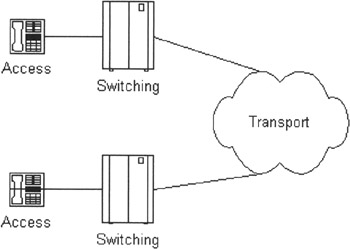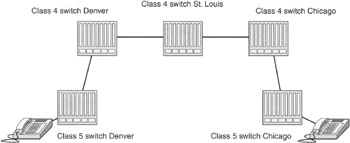Telecommunications Networks-The Need for an Alternative Form of Access
|
|
An understanding of the PSTN is best grasped by examining its three major components: access, switching, and transport (see Figure 1-1). Each element has evolved over the 100-plus-year history of the PSTN. Access pertains to how a user accesses the network. Switching refers to how a call is switched or routed through the network. Transport describes how a call travels or is transported over the network. This network was designed to handle voice. Eventually, data was introduced onto this network. As data traffic on the PSTN grew, high-capacity users found it inadequate. These subscribers then moved their data traffic to data-specific networks. Many data users find themselves limited to an infrastructure that is dependent on wires, whether they are using fiber-optic cable, coaxial cable, or twisted-pair copper wire. Although wireless communication is not new (forms of radio communication have been in use for almost a century), using wireless communication to bypass wired monopolies is now a practical opportunity for subscribers of both voice and data services. The primary form of bypass is the use of cellular phones. The wireless technology 802.11b also holds great promise in delivering broadband data (up to 11 Mbps).

Figure 1-1: The three components of a telephone network- access, switching, and transport
Access
Access refers to how a user accesses the telephone network. For most users, access is gained to the network via a telephone handset. Transmission and reception occurs via diaphragms where the mouthpiece converts the air pressure of voice into an analog electromagnetic wave for transmission to the switch. The earpiece performs this process in reverse. The most sophisticated aspect of the handset is its Dual-Tone Multifrequency (DTMF) function, which signals the switch by tones. The handset is usually connected to the central office (where the switch is located) via copper wire known as twisted pair, because, in most cases, it consists of a twisted pair of copper wire. The stretch of copper wire connects the telephone handset to the central office. Everything that runs between the subscriber and the central office is known as the outside plant. Telephone equipment at the subscriber end is called customer premise equipment (CPE). One of the chief reasons the majority of subscribers have no choice in local service providers is the prohibitive expense of deploying any alternative to the copper wire that now connects them to the network. Secondly, gaining right-of-way across properties to reach subscribers borders on the impossible both in legal and economic terms.
Switching
The PSTN is a star network; that is, every subscriber is connected to another via at least one, if not many, hubs known as offices. Those offices contain switches. Very simply, local offices are used for local service connections and tandem offices are used for long-distance service. Local offices, better known as central offices, use Class 5 switches and tandem offices use Class 4 switches. Figure 1-2 details the relationship between Class 4 and Class 5 switches. A large city might have several central offices. Denver (population 2 million), for example, has approximately 40 central offices. Central offices in a large city often take up much of a city block and are recognizable as large brick buildings with no windows.

Figure 1-2: The relationship between Class 4 and Class 5 switches.
Transport
The PSTN was built at great expense over the course of more than a century. Developers have been obsessed over the years with getting the maximum number of conversations transported at the least cost in infrastructure possible. Imagine an early telephone circuit running from New York to Los Angeles. The copper wire, repeaters, and other mechanisms involved in transporting a conversation this distance were immense for the time. Hence, the early telephone engineers and scientists had to find ways to get the maximum number of conversations transported over this network. Through much research, different means were developed to achieve the maximum efficiency from the copper wire infrastructure. Many of those discoveries translated on technologies that worked equally well when fiberoptic cable came into the market. The primary form of transport in the PSTN has been time-division multiplexing (TDM). In the 1990s, long-distance service providers (interexchange carriers [IXCs]) and local service providers (Local Exchange Carriers [LECs]) migrated those transport networks to Asynchronous Transfer Mode (ATM). ATM is a means of transport from switch to switch. The emergence of Internet Protocol (IP) backbones is drawing much of the traffic off ATM networks and moving it to IP networks.
|
|
EAN: 2147483647
Pages: 96